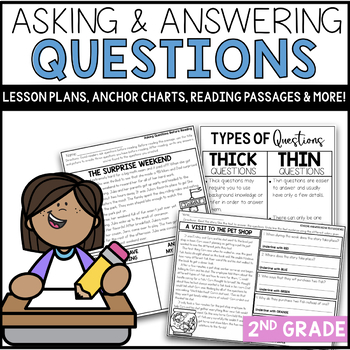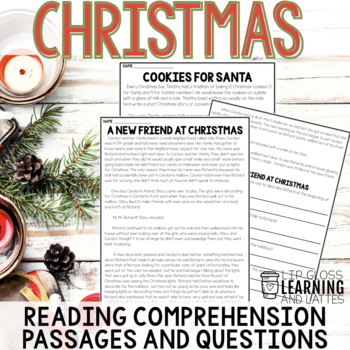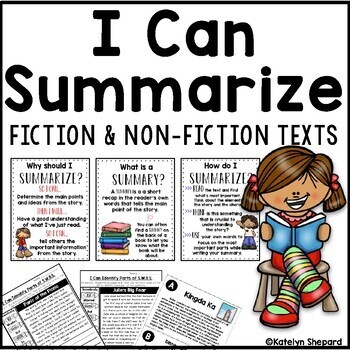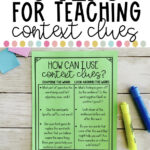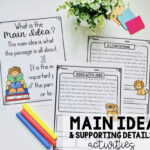Asking and Answering Questions
At the start of each school year, I love to cover the “Ask and Answer Questions Standard” (CCSSR.L.2.1). This standard works perfectly for the beginning of the school year, because it’s relatively easy for students to get the hang of and essential when understanding the texts throughout the rest of the school year. In 2nd grade, this standard requires that students are to understand key details in a text by asking and answering questions such as who, what, where, when, why, and how. I believe this to be one of the most critical reading standards there are. Today I’ll share with you tips for teaching asking and answering questions as well as resources (and freebies) you can use with your students to teach the standard R.L.2.1.
1. Begin by teaching the 5 w’s
To introduce this standard to students, I like to begin by introducing each of the 5 W’s + H. The 5 W’s + H being who, what, where, when, why, and how. You can do this by showing a set of 5 W’s posters like these. Discuss how these are all questioning words that will help us collect important information from a text. I like to start by reviewing posters like these, because the posters are often referred to as we continue to work through the ask and answer questions standard.

After discussing the 5 W’s, the remainder of class can be used to answer questions about a short passage, using the questioning words who, what, where, when, why, and how. With all reading lessons, I recommend splitting up instruction into the I Do, We Do, You Do model.
Model:
Model filing out a 5 W’s graphic organizer for students using one passage, reviewing what each of the questioning words is used for. Then, partner students up, giving them a bit of support as they complete the same 5 W’s graphic organizer with a partner using a different story. Finally, allow students to complete one more graphic organizer using a third story on their own.
You can find these 5 W’s Graphic Organizers inside of my Asking and Answering Questions Pack.
2. Teach Thick and Thin Questions
It’s important for students to understand the different types of questions and when to ask them. I like to spend a day or two teaching the difference between “thick and thin” questions.
- Thick questions are questions that aren’t always easy to find the answer to and may require background knowledge.
- Thin questions are questions that are usually much easier to answer and the answers can be found by going back into the text.
Model:
One way for students to become familiar with both types of questions, is to give them several of examples of each. You can do this with a simple sorting activity like the one shown below. Students will eventually begin to see the difference between thick and thin questions.
Model sorting through a few examples of both types of questions, making sure to take time out to discuss why one counts as a thick question and the other a thin question.
4. Teaching Students to Ask Questions Before, During and After Reading

Once students are familiar with the types of questions they might ask or answer, they should become familiar with WHEN to ask these questions while reading a text.
Explain to students that as good readers, it’s important they ask questions before reading, while reading and after they read. Doing so will help them to monitor their comprehension, making sure they understand what they are reading. What’s the point of reading something if we don’t understand it? I like to spend one day each to teach asking questions before, asking questions during and asking questions after reading.
Model:
To get students familiar with asking questions before, during and after reading, the same approach can be taken when teaching each of them. I think you’ll find your students love the predictability of the lessons too!
Asking Questions Before Reading
Model previewing the book or story with students. Explain to students that we use things like the cover, the title and even background knowledge of the topic or author to come up with questions BEFORE reading the story. Model asking questions before reading such as:
- “What do I want to learn?”
- “What do I think the problem will be?”
- “Is this story fiction or nonfiction?”
Asking Questions During Reading
We ask questions DURING reading to check our comprehension of the text. To model this, begin reading a new story (if students have already read the book there won’t be much to ask). At various points in the story model asking questions such as:
- What might happen next?
- What do I think the story is about?
- Do I understand what I am reading or do I need to reread the last part?
Asking Questions After Reading
To model the final part, asking questions after reading, explain to students that we ask questions AFTER reading to see if our predictions were correct, our questions were answered and to determine what we’ve learned. Share questions such as these with students:
- Was my prediction about the story correct?
- Why did the author write this book?
- Did I learn anything?
After each day of modeling asking questions before, during and after reading, I like to give students the opportunity to create their own, text specific questions. This page out of my Ask and Answer Questions Activities Pack is helpful for students because it has sample questions provided for students.

5. ASk and answer Questions about key details in a text
This is where your students put everything they’ve learned about asking and answering questions together and master locating key details in a text, most likely to answer comprehension questions. I always stress to students that they must be able to “prove” their answers, not just recall an answer they think they read. Just like with every lesson, in order to teach students how to find answers using text evidence, start by modeling exactly what you want students to do.
Model:
Using the book or reading passage of your choice, model stopping at different points to answer the questions about the text. If it’s a printed passage you are using, model underlining the answers you’ve found to the questions directly in the passage. This is a great way for students to see the text evidence.
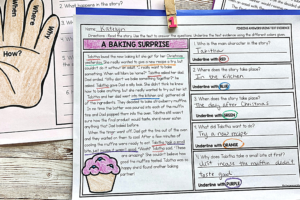
You can find ask and answer questions activities like this in my Ask and Answer Questions Reading Passages and Activities Pack.
When locating text evidence, I like to model with and have students use different colors to underline their answers in the text. Then, after a whole group lesson, split students up into groups and have them work together to locate text evidence in a second passage. Finally, for independent practice, have students use a third and final passage to read and answer the comprehension questions for. By now, they will have plenty of practice locating the text evidence and underlining the answers using different colors within the text.
PRACTICe AskING AND ANSWERING QUESTIONS about key details in a text
Asking and answering questions is such a crucial skill for students’ comprehension, so giving them consistent opportunities to practice throughout the year is important! You can find even more resources that address the standard CCSSR.L.2.1 down below!
What are your favorite ways to teach asking and answering questions?

